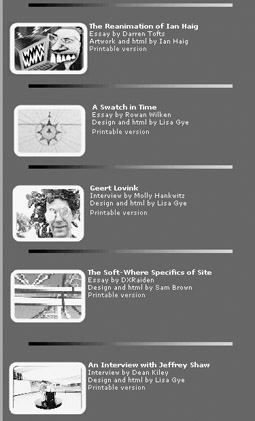MESH 14: resisting the global narrative
Esther Milne

MESH 14: resisting the global narrative
‘Globalisation’: a term just ripe for a bit of Goerring/Godard inspired appropriation isn’t it? You know, ‘whenever I hear the word globalisation, I reach for my…’ But that’s just the point. What does one ‘reach for’ in the age of simultaneous presence, virtual subjectivity and networked environments? After all, the effort to reduce space between objects seems a little redundant if the “resistance to distance” in Paul Virilio’s words has “finally ceased” (Open Sky, Verso, London, 1997). For the contributors to Experimenta’s MESH 14, the reach and liminality of globalisation is anything but settled and, therefore, it is a term emphatically contested. Edited (and predominantly designed) by Lisa Gye, and for the first time peer reviewed, MESH 14 brings together a range of writers, artists and critics currently working in experimental film, net activism and new media art. In different ways, these authors refuse to accept the term ‘globalisation’ as a given, the irreversible and inevitable march of progress. Rather, it is a narrative always in formation; a story produced from competing technologies and conflicting economic and social exigencies. As Geert Lovink reminds us in Molly Hankwitz’s interview, it gets portrayed as “seductive and fatal, unavoidable.” How can one critique globalisation, he asks, “if it is presented to us as a meta-level historical process? It is like being against the Middle Ages.”
Part of the narrative of globalisation is, of course, informed by tensions between the global and the local; or between public performance and domestic practice. This point is comprehensively explored by Rowan Wilken’s “A Swatch in the Fabric of Time.” Wilken argues that in order to understand the patterns and rhythms of computer networks we need to acknowledge the impact of the ‘everyday’: “computer-mediated communication and the endless flow of global informational and media vectors is a priori anchored in the flows of the everyday—the global is filtered through the local.” Taking Swatch’s invention of “Internet Time” as his starting point, Wilken’s is a fascinating survey of the kinds of critical practice and theoretical acumen necessary for coordinating the spatio-temporal dimensions of “globalised communications.” As part of this approach, Wilken runs a nice line in genre hybridity and media recycling by including a “side bar” of ficto-theoretical whimsy that gestures toward an almost 19th century media form: the list. Wilken’s inventory is rather more Borges than Baudelaire in its remit including such disparate items as “Panasonic Digital answering system with perpetually stiff keypad” and “improvised tea/coffee coaster in the form of a miniature ceramic replica of the fishes and loaves mosaic from the Church of the Multiplication on the shores of the sea of Galilee (a gift).”
Another media form recycled from an earlier technology is the interview. Indeed, the relation between new and old media is a focal concern for the 2 interviewees. Geert Lovink wonders about the possibility for a “moratorium on the further development of computer hard and software.” This might focus attention on “other levels of deficit” within cultural and economic production. Hankwitz and Lovink speculate about the potential for a “more inclusive and multicultural” avant-garde. Lovink is less than sanguine about the current situation, arguing that we urgently need a new direction “away from the boys and toys culture.” Dean Kiley—as adjectively flamboyant and critically perceptive as usual—interviews “renowned new media artist” Jeffrey Shaw (an expanded version of an interview originally appearing in RT #41 p18). While discussing Place Urbanity (Shaw’s computer based interactive media installation for the Australian Centre for the Moving Image in Federation Square) they make some interesting points about the historical specificity of the relation between art and theory. DX Raiden also explores those entangled twin logics in his elegant piece—with gorgeous design and html by Sam Brown—entitled “Soft-Where Specifics of Site.” The authors critique a number of theoretical mappings of spatial politics within digital and concrete environments.
In keeping with MESH’s preoccupation with all things recombinant, Darren Tofts’ delightful piece on Ian Haig reads him as a “reanimator”: “low tech and outmoded are, in Haig’s hands, the signatures of funk, the beat of satire.” Particularly satirical—and certainly an analysis of the tension between new and old technology, differing channels of discourse and the technologised body—is Haig’s most recent work, The Excellsior 3000. With a name which to my mind sounds suspiciously like WeightGain 4000 (‘may cause irreversible damage to the kidneys and liver’), it is not altogether surprising to find this project has something to do with evacuation technology. Haig describes it as “the construction of 3 large scale futuristic toilet installations…resembling all purpose custom built media stations” showing “videos to aid the digestion and assist bowel movements.” As Tofts quips, “toilet technology is one of the great unsung watersheds in the history of the becoming machinic (certainly one that Donna Haraway seems to have missed).” My only complaint is that there are no electro farty noises on the site (what a pissy).
MESH 14 is an exciting and thought provoking read. It is also, importantly, beautifully designed: lovely clean lines; a pleasure to navigate and spatially uncluttered (please excuse antiquated bourgeois aesthetic of ‘taste’; Eminem has promised to drop round later to rectify the situation).
MESH, Experimenta’s media arts journal, issue 14: globalisation, editor Lisa Gye, commissioning editor Keely Macarow,
www.experimenta.org/
RealTime issue #42 April-May 2001 pg. 21






